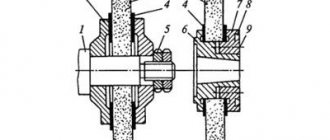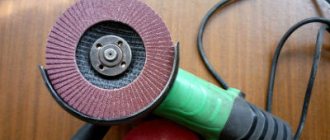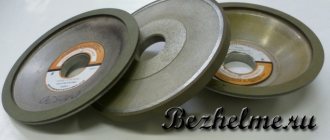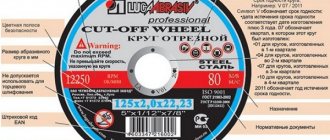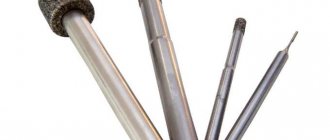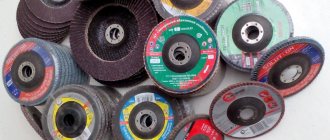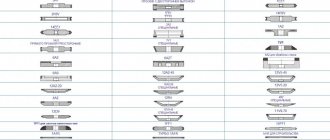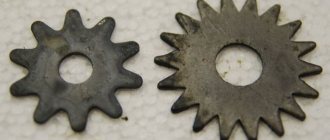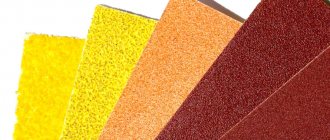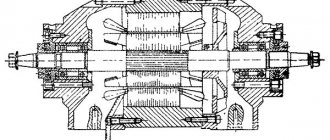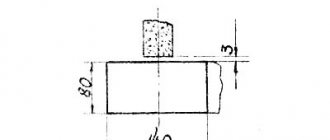The need to obtain a smooth surface free of flaws arises not only in industry, in the manufacture of various types of parts, but also at home. The result is achieved through mechanical processing with special tools or machines. Grinding is impossible without a variable selection of various equipment depending on the task being performed: removing paint and cleaning rust before painting, preparing a metal workpiece, sharpening blades, knives, axes, saw chains and discs, and even processing before coating. From this we can conclude that abrasive grinding discs are a universal tool, actively used not only in industry, but also by home craftsmen.
What is a grinding wheel?
It belongs to the cutting abrasive group, used on machines of the same name for manual processing of various types of parts. This gives the product an attractive appearance, as well as the necessary technical characteristics. As a result of mechanical action, irregularities and relief disappear.
The surface of the wheel is porous, many abrasive grains are applied to it, as well as natural and artificial binders.
The main material for production is a composite consisting of a strong base, which is evenly filled with small cutting grains. Initially, the role of an abrasive was played by hard sandstones and other artificial materials, but now they have been completely replaced by artificial ones.
The circle consists of 3 elements:
- abrasive grains;
- ligament;
- pores.
The connecting element is responsible for operational safety. It is necessary to hold the clutch in place at high speeds. The grains ensure an open structure of the grinding wheel. This makes it easier for coolant to enter the work area and move chips away from the grinding area. Quality tools support trouble-free sanding. Thanks to the operation of the wheel at high speeds, the grains easily crush heavy and durable material, showing precise work.
Solid particles eliminate unnecessary elements and effectively act on the surface. It is allowed to process coatings made from carbon steel, ductile iron, durable plastic, bronze, non-ferrous metal, glass and wrought iron.
Grinding wheels are capable of cutting bricks, roofing slate, drywall, ceramic and concrete products. They facilitate impact on various surfaces; with their help, grooves and sections of the required depth and shape are made.
Where is it used?
Polishing is actively used not only in industry, but also in everyday life. This is justified by the attractive appearance of the polished surface and the need to impart certain technical characteristics. Interior elements, timber and panel elements are exposed during the fitting of parts. Particular attention is paid to the degree of surface smoothness in the driving units. Neglect will cause the equipment to quickly fail, since good fit of parts and minimization of friction are critical.
Straight grinding discs are actively used to remove rust and other types of contaminants from metal. Abrasive wheels for sharpening machines make sharpening sharp cutting tools easier.
The product is beloved by jewelers who polish precious metals. They are involved in working with semi-precious stones and ornamental minerals.
The variable shape makes it easier to machine and grind the surface of a curved object. Moreover, the abrasive itself can act as a template for the profile of the plane being processed. For fine grinding, discs with fine grain and soft bond are used. They are gently applied to the part to give it the required level of cleanliness.
There are grinding attachments for the drill. They act as indispensable assistants during renovation activities (cleaning walls before laying tiles, etc.). Installation on an electronic sharpener makes it easier to remove rust and old paint from pipes.
Wheels with a tail belong to a separate category; they are needed for working with hand-held power tools equipped with clamping chucks.
Grain classification
One of the defining characteristics. The result obtained, the size of wear, productivity, and the thickness of the layer removed in one pass depend on it. When choosing, take into account the requirements for surface cleanliness and the nature of the grinding operation. As the grain size decreases, the purity of the processing increases. This reduces the speed of work. For face grinding and finishing of copper and brass parts, it is recommended to use coarse-grained nozzles.
Coarse-grained circles are relevant for:
- flat face grinding with a large contact area;
- when working on machines with high power and rigidity;
- finishing material that clogs the pores of the wheel and greases;
- roughing and preliminary preparation with large cutting depths and removal of large allowances.
Medium and fine-grained are used in cases where processing accuracy comes first:
- when obtaining a roughness of 0.32 - 0.08 microns;
- impact on hardened steel and hard alloys;
- final grinding and finishing of equipment;
- turning.
The described characteristic is measured in microns. There are two marking systems:
- GOST 3647-80 Soviet standard, with a numerical designation system. The number one corresponds to 10 microns. In other words, 20 is 200 microns.
- GOST R. 52381-2005. The standard is based on the globally accepted FEPA marking. The letter F and a specific number are used to indicate grain size. The numerical value is the reciprocal of the abrasive size. For example, F70 = 200 - 250 microns, and F40 is equal to 400 - 500 microns.
Types of abrasive
The use of materials is regulated by GOST 28818. The product must be hard, have low thermal conductivity, resistant to frictional wear (the combined effect of sliding speed and high pressure), and have high surface hardness.
The above requirements meet:
- Electrocorundum on bauxite with a base of high-percentage aluminum oxide and calcium oxide. It is characterized by increased hardness, which remains unchanged even when exposed to high temperatures, which invariably occur at the point of contact with the object. Such products are marked as follows: 12A ... 15 A (normal), 22A ... 25A (white). The strength index increases with increasing hardness of the base substance.
- Electrocorundum with carbide base. The most common contents of chromium, titanium, zirconium and silicon carbides. Markings start from 38A (zirconium only) to 95A (chrome and titanium). Metals are resistant to shear stress. Thanks to this, they can be used to remove the top layers of a part after heat treatment or straightening them. Due to silicon carbide (52C - 65C), resistance to temperature changes increases; as a rule, they are used when working with non-ferrous metals, alloys and cast iron.
- Spherocorundum. To obtain it, molten aluminum oxide is blown. As a result, it acquires a spherical grain shape (in electrocorundum they are mostly flat). The abrasive gains high hardness. It is marked with the designation ES. Spherocorundum is used for grinding materials of increased hardness.
- Monocorundum (43A - 45A). The main difference from other abrasives is the grain structure, here it is monocrystalline. This feature had a positive effect on service life. The disadvantages include high cost, since growing monocrystalline grains is a complex and labor-intensive process. A more affordable alternative includes aggregated monocorundum, obtained by combining poly and monocrystalline sections.
Types of ligaments
The second most important component. The scope of application depends on it. Acts as a connecting link that prevents the destruction of the abrasive mass. The bond affects the type of attachment to the body base. As an example, we can mention a film mount, which is compatible only with ceramic ones and is not at all suitable for bakelite ones.
The following types are distinguished:
- Bakelite. It is characterized by high polishing qualities. Disadvantages include low resistance to aggressive chemical environments and limitations in rotation speed (for manual machines). Bakelite bonded tools are heavy and suitable for working with metal. The main scope of application is finishing. Allows flat grinding and sharpening.
- Ceramic. The most popular group. Its components are of inorganic origin (clay, quartz, sand, etc.). The components are ground before adding. The result is a hard but fragile circle. The low weight allows the product to be accelerated to high speeds, but it must be protected from bending loads, since it has a low coefficient of resistance to mechanical stress. Received fire-resistant qualities superior to competitors. Chemical resistance is at a decent level. Maintains edge profile well.
- Magnesian and silicate. Low strength is compensated by minimal heat generation during operation. The group is sensitive to coolants.
- Vulcanite. The basis is synthetic rubber that has undergone heat treatment. In other words, it has gone through a vulcanization process. Due to its dense structure, it generates an increased amount of heat. Needs periodic breaks, otherwise it will soften to such an extent that the result will suffer. Strict adherence to operating standards guarantees an impeccable result. Considering this circumstance, the bond is in demand for finishing complex shaped planes and in profile grinding. The purchase will result in significant financial losses.
- Metal. In demand for finishing superhard alloys.
Type of grinding fluid
Has a significant impact on the final result. They lubricate the circle, and thereby reduce the amount of heat dissipated.
In other words, liquid is needed for cooling, since distortion occurs when heated. In addition, friction between the equipment and the chip is reduced. Reducing the load improves the quality of the finish. And the most obvious function of coolant is to keep your work area clean.
- Synthetic. The composition does not contain mineral oil. Contains corrosion inhibitors and wetting agents. They dissolve easily in water and form a transparent layer. Lubricating and cooling qualities at the appropriate level contributed to the involvement of this group in machine maintenance.
- Emulsion. A symbiosis of two liquids that do not dissolve in each other. The composition contains from 30% to 70% mineral oil with corrosion inhibitors and wetting agents. Liquids are represented by opaque milky solutions.
- Semi-synthetic. A mixture of synthetic and natural emulsifiers. When dissolved in water, the group forms a translucent consistency. Contains 10% - 30% mineral oil, anti-corrosion inhibitors and wetting agents.
The choice of coolant is influenced by the specifics of the tool and the cutting method. Special attention must be paid to the water used and its hardness. It is important to determine the degree of surface contamination and the filtration system.
Hardness
The characteristic determines the ability of the grain to maintain its shape under the influence of external factors. As it decreases, the rate of destruction of the abrasive increases. The grain must fully exhaust its resource. After this, fall out and reveal the next layer of abrasive. The most common equipment is with average hardness. But the choice is influenced by the type of tool used and the material that needs to be finished. The quality of work depends on the decision. An insufficient level will lead to rapid wear of the equipment, excessive hardness will negatively affect the surface being finished, cracks, burns and chips will occur.
Marked as follows:
- M - soft;
- ST - medium hard;
- T - solid;
- CT - extremely hard.
Form
- Flat circles with straight profile (PP1). The main area of application is sharpening. As a rule, the end is used as a working surface. They are suitable for round, external, internal, centerless grinding and flat machining around the periphery of the wheel.
- With ring profile. They have an extended end. A technical feature has increased the processing area. Performs similar tasks.
- With double-sided conical profile. The shape makes it easier to finish various types of recesses. Particularly suitable for grinding teeth, gears and threads.
- With double-sided groove. Will interfere with the object in the clamping flanges. Due to this, it is not only polished, but also the end is trimmed. In demand for centerless grinding.
- Cylindrical and conical circles-cups. Suitable for sharpening and flat grinding. The shape is similar to straight profile circles with a conical groove. The difference lies in the end, placed at right angles to the plane.
- Disc-shaped. The specific configuration and small size of the end made the group in demand for sharpening and finishing the front edges and teeth of slotting tools.
What are they?
- Velcro. Made from leather on a Velcro base. It is mounted on a support with a self-adhesive backing. The texture is in demand in wood and metalworking, repair, construction and is considered consumable. The minimum size is 125 mm. The grain size is variable. It is marked in different colors (brown - wood and metal, blue - stainless steel, black - minerals). The classic set includes felting, polishing and sanding patterns. Thanks to this, it is possible to finish almost any surface. Installed on grinders, eccentric sanders and hand drills.
- Petalaceae. A highly specialized group that received an emery base. It has the same shape; they mainly resort to processing wooden planes. It is used for primary polishing and grinding. Made in the shape of a fan. The design provides increased wear resistance. Sufficient for processing up to 10 km2.
- Fiber. The base is obtained by processing cellulose. Used for cleaning welding seams, spatter, processing steel, non-ferrous and ferrous metals.
- Diamond. The group is characterized by an optimal balance of fragility and strength with an impressive working margin. Used to interact with carbide materials, ceramics, precious and ornamental stones.
Sanding wheel grit
When purchasing an emery grinding wheel for their machines, consumers pay attention to such a characteristic parameter as grain size. It can take the following values in the standard version - 8, 12, 16, 25, 40. It is clear that 8 are products with the smallest grains, and 40 are, accordingly, the largest.
The choice of grain size should be carried out exclusively professionally. Otherwise, either the sharpening work will be done poorly, or the emery wheel itself will not last long. Fine grit is great for jewelry sharpening, while coarse grit is great for heavy, large tools that do not require high precision.
There is another important parameter that concerns grain - its resistance to abrasion. There are so-called medium-soft products (they are labeled SM), as well as medium-hard ones (respectively, ST). The first option in our country, and throughout the world, has become quite widespread. This is due to the relatively low cost of the product, as well as acceptable characteristics. It works for a long time even under fairly heavy loads. As for medium-hard grain, it is even more resistant to mechanical stress, including abrasion. However, such a product costs many times more, which significantly reduces the economic feasibility of the purchase.
From this perspective, we can consider some examples of product labeling and their appropriateness for use in a given situation. So, for example, an emery wheel marked 150x8x32 12-CM is often used to sharpen skates. What does it mean?
- The disc has a medium-soft grain, which is relatively cheap and allows for high-quality sharpening.
- The grain size is 12-H - 12 microns in diameter, if we take the average.
- 32 mm is the fitting diameter, which is standard for many equipment.
- 8 mm is the thickness of the product itself. This is a very small indicator, which does not ensure structural strength when working with a large tool under high loads, but it is quite suitable for the intended purpose.
- 150 diameter sanding wheel.
Let's look at another small example. For everyday life and production, abrasives 150x20x32 25-CM are installed on emery surfaces. In this example, in comparison with the previous one, the width of the product is increased to 20 mm, and the grain diameter is increased to 25 microns. In fact, this turns out to be a fairly universal machine that will allow you to work not only with small tools, such as scissors, knives, screwdrivers, but also with fairly large devices, such as axes and some saws.
How to choose?
Before you make a choice, you need to determine the capabilities of the sharpening machine. We are talking about power, operating speed and whether they can be adjusted. It is necessary to find out how important cooling and lubrication are. Violation of the manufacturer's recommendations will lead to the fact that the abrasive will quickly lose its qualities and the object being processed will be damaged.
The following parameters deserve careful attention.
- Grain. Depends on the nature of the work performed and the surface. Accurate and precise processing will require products with medium to fine grain. When it comes to rough finishing of an object, interaction with materials that pores clog the surface, they resort to coarse-grained equipment. The smaller the grain size, the slower the operation progresses.
- Diameter. The parameter must match the cutting tool. Universal products received a diameter of 125 - 150 mm. They are lightweight and help in solving various household tasks. The study of the parameters of the mounting hole deserves special attention. The standard values are 22 and 32 mm. For a drill, 10 mm is relevant.
- What material are they working with? It is important to ensure that the abrasive matches the finishing material. The relevant information is presented in drawings (stone, concrete, ceramics, metal, etc.) on the product. Circles can be universal.
- Rotational speed. The characteristic must exceed the maximum permissible performance of the grinding machine. It varies from 50 to 100 m/s. Marked in different colors (green 100 m/s, red 80 m/s, yellow 63 m/s).
- Thickness. Standard sizes range from 1 to 5 mm. It affects the speed and accuracy of the cut. The thin disc cuts efficiently and quickly, but quickly becomes unusable. When interacting with hard metals, they bend and break.
- Bundle type. It determines the nature of the work performed and durability. Each group performs well when performing certain tasks.
- Class of imbalance. Affects balance. Thorough mixing of grains and binders will eliminate the existence of heavy and light areas on the surface. The balanced disc rotates evenly and finishes the surface well. The characteristic affects the service life. There are 4 classes of imbalance (1st is considered the most accurate).
- Hardness. The most common ones are considered to be with an average indicator. The choice depends on the material and tool.
- Circle density (structure). It indicates the distance between two grains. Highlight:
- closed - for metals and aggressive grinding;
- semi-open - non-ferrous metals, paints and varnishes, plastic;
- open - wood finish.
Types of discs for grinders
Grinder circles are replaceable elements. When working with different materials, you need to understand their types. This will help to perform the necessary operation efficiently. Circles are classified according to the following parameters:
- by appointment;
- type of work performed;
- design;
- type of cutting;
- material of manufacture;
- sizes.
Depending on their purpose, there are attachments for working on metal, wood, stone, concrete, marble, etc. Manufacturers indicate the purpose in the marking, which is applied directly to the product itself. Many varieties are universal tools, suitable for processing several types of materials.
Based on the type of work performed, as indicated in the title, manufacturers produce the following attachments for angle grinders:
- stripping (metal brushes, end flap wheels, with mandrel, batch);
- roughing (grinding wheels, twisted cutters, diamond roughing wheels);
- saws The presence of teeth on the cutting edge is a design feature of the product. This allows you to obtain particularly clean cuts on wood, plasterboard, gas silicate, plywood and other similar materials;
- cut-off Cutting and diamond discs are produced with a continuous cutting edge and divided into segments;
- grinding (discs with varying degrees of grain size and hardness);
- polishing (felt, felt, with special Velcro and grinding attachments);
- for cutting joints in asphalt, concrete, etc.;
- milling (for cutting grooves, bowls, edge processing, etc.);
- sharpening A characteristic feature is the ability to perform operations with the side surface.
The disk is a product of a certain diameter and thickness, which has a mounting hole for attachment to an angle grinder with a cutting edge of a solid, segmented or shaped configuration.
The choice of a specific type depends on the operation being performed and the material on which it will be performed. Cutting using such attachments can be done dry, wet or combined. The labeling indicates this feature. Depending on the material used, the discs can be abrasive, carbide, diamond or brush. The basis of the first type of circles is special latex paper or fiber, onto which an abrasive layer with a binder is applied. The nozzle, made of fiber, comes with a rubber or plastic support plate. Carbide disc is a product made of alloy steel. Such consumables can be used for cutting aluminum, stainless steel, high carbon steel and other materials, as indicated in the marking.
Diamond blades are a universal consumable. It is a steel product with diamond coating applied to its surface. This allows you to get the thinnest cut in any material. Popular products, popularly called turtles, are a type of attachment made on a flexible base, have a grooved structure and are attached with Velcro. In addition, they produce diamond blades with a solid edge for cutting in the wet method, segmented and turbo-segmented for cutting in the dry method, and combined ones.
The best abrasive and velcro grinding wheels
Hanko DC341.150.15.0120 150 mm
Got a polyester backing that is high strength and wear resistant. The abrasive was aluminum oxide, and the binder was mineral resins. The equipment guarantees good results. The cutting speed is significantly superior to the competition on paper. Can be installed on eccentric sanders.
Hanko DC341.150.15.0120 150 mm
Advantages:
- Velcro fastening;
- moisture resistance;
- dust-repellent coating;
- long-term operation;
- finishing of wood, metal and paintwork materials is possible;
- made in Korea.
Flaws:
- overheats quickly.
BISON 3592-180-H11 180 mm
The Expert set from the domestic company Zubr is used for preliminary, intermediate and final grinding. It is used to finish wooden and metal products, as well as paint, chrome and nickel plated surfaces. The main feature of the set is a unique glove with an anatomical structure and 10 Velcro attachments.
BISON 3592-180-H11 180 mm
Advantages:
- long-term operation;
- an orthopedic glove improves the quality of processing;
- manual polishing of the car in hard-to-reach places is possible;
- polyurethane nozzle for collecting water on planes with complex terrain.
Flaws:
- diameter 180 mm;
- Skins with a diameter of 150 mm are almost impossible to find.
Hammer 227-001 125 mm
A product from a well-known company that needs no introduction. It has proven itself on the positive side, having been producing equipment for decades. During this time, it has gained the authority of a reliable company with high-quality products.
The new support plate continues the established tradition. It is made of high strength plastic. Fastening is carried out with a standard M14 shank. The model is additionally equipped with an adapter with a drill pin.
Hammer 227-001 125 mm
Advantages:
- convenient adapter for clamping chuck;
- reliable fastening;
- quick installation;
- no play.
Flaws:
- under prolonged loads it quickly fails.
What kind of circles are there for emery - another educational program
Many people have an emery machine at home - an electric machine equipped with grinding wheels. Most often, something is sharpened or polished using emery. There are a lot of abrasive grinding wheels on sale; in addition to them, it is convenient to use diamond grinding wheels in everyday life. However, for initial processing, for rough processing of metal, it is better to use abrasive wheels. Let's look at the classification of sanding wheels, what they are and where they are used.
White circles - they are made of electrocorundum 25A
The most popular wheels, since they are designed for processing non-hard metals, are perfect for the home. Sharpen knives, axes, scissors, process ordinary steel (corners, etc.) - such a circle will work just fine. Huge selection of sizes and mounting holes:
The marking of electrocorundum 25A is most often white. Sometimes manufacturers add a coloring element, which can result in the circle being blue or orange. When turning ordinary metal on such a wheel, a very high-quality sharpening is obtained, since the composition of the wheel itself is soft, the temperature during friction is low, so blue scale does not appear on the metal, and since there is none, the metal retains its properties perfectly.
This primarily applies to knives and other cutting objects, since it is very important not to overheat the metal when sharpening. So an alumina grinding wheel is a great choice for your home.
The sizes of circles are different for different machines. The fit is most often 32 mm - if you buy a wheel for home emery. The most common circle sizes are 125, 150, 175 and 200 mm in diameter, fit 32 mm and thickness 10, 16, 20, 25 mm. As you know, sandpapers for home use come in different sizes, which is why the wheels come in several sizes.
Green circles - made of silicon carbide 64C
Green wheels are intended for processing tool steel and hard alloys (for example, brazing on drill bits for a rotary hammer).
The material is more resistant to abrasion, the temperature during sharpening is high, so if you decide to sharpen a kitchen knife with this circle, you will probably ruin the knife, since scale will appear on the blade instantly.
Therefore, such a wheel is used only for turning tools made of tool steel (R6M6, R18, steel with the addition of cobalt, also hard alloys VK8, T5K10, T15K6). Of course, sharpening carbide is also not very convenient; you need to use the finest grain of the wheel, but it is best, of course, to sharpen carbide with diamond sharpening wheels.
The marking of the circle is 64C, the dimensions are the same as for electrocorundum.
It is worth noting that in addition to small wheels for everyday use, large-diameter grinding wheels are produced and placed on large machines. The fit of such circles is 76 mm, 127 mm and 203 mm.
Diameters 250, 300, 350 and 400 mm. Electrocorundum and silicon carbide.
These are large, heavy and expensive wheels to produce. For example, here I am holding a circle 64c 400*40*127 25CM - photo:
What kind of “grain” is there?
Many who buy grinding wheels for emery do not even know how the grit is marked. I think this point also needs to be covered in more detail.
So, the grinding wheel grain is 8, 12, 16, 25, 40-N.
8 is the smallest, 40 is the largest.
In addition to the numbers, you can also see the letters SM - this means a medium-soft circle, the most common because it is not very expensive and endures quite well. A little less often you can find ST grain on sale - medium-hard, its cost is noticeably higher, however, the abrasion resistance is much higher.
For precise sharpening, of course, it is better to take a fine grain, 12 or 16. Often they buy wheels for sharpening skates from us, these are 150 * 8 * 32 12 CM - a wheel with a diameter of 150 mm, thickness only 8 mm, fit 32 mm, fine grain, allows for sharpening just perfect.
For example, to install an emery wheel on a 150 mm machine, it is best to buy one 150*20*32 25 CM - a standard wheel for emery with a diameter of 150 mm, fit 32 mm, wheel width 20 mm. Grit 25 - medium, suitable for sharpening both small tools (knives, scissors) and large ones - axes. SM - a standard medium-soft circle for household use is also suitable. Such a circle costs about 120 rubles.
Among the manufacturers, I recommend grinding wheels produced in the city of Volzhsk - excellent quality (the wheels do not fall apart and last for quite a long time), low price, delivery by transport companies throughout Russia.
Best Flap Abrasive and Grinding Wheels
MESSER 80x50x6 Medium
The model is designed for straight grinders, collet 6 mm. Electrocorundum was used as an abrasive. It performs well when cleaning and matt fine processing of stainless and alloy steels, bronze, copper and aluminum.
MESSER 80x50x6 Medium
Advantages:
- maximum rotation speed - 4800 rpm;
- easy interaction with curved planes and threaded connections;
- variable grain size (100, 180, 320);
- made in Russia.
Flaws:
- diameter - 80 mm.
Bosch X781
The “target audience” of the product is angle grinders. One of the best solutions for treating stainless, sheet and regular steel, as well as cast iron. Productivity at the proper level is maintained by ceramic corundum of increased purity. The role of the binder is performed by synthetic resin and durable X-fabric. The abrasive uses a fiberglass pad.
Bosch X781
Advantages:
- Self-sharpening ceramic abrasive extends service life;
- angular design facilitates finishing of edges, welds and grinding of planes with an angle of 15 - 25;
- diameter - 120 mm;
- light weight.
Flaws:
- not widely available on shelves (they sell out quickly).
DRONCO 5211384
Made from cotton and polyester. This combination gave flexibility, wear resistance and durability. The product does its job quite quickly. The base is fiberglass mesh. It can withstand heavy loads and ensure uniform grinding. Leaves no traces.
DRONCO 5211384
Advantages:
- decorative finishing possible;
- rotation speed 13280 rpm;
- exceeds the wear resistance of competitors 3 times;
- reliable fixation;
- German quality.
Flaws:
- overheats.
The best fiber abrasive and grinding wheels
Bosch K24 180 mm
The new product is suitable for servicing cars at home and at service stations. The equipment received zirconium corundum of high purity. The role of the binder is performed by a composition of synthetic resins and vulcanized fiber. Suitable for fine and rough grinding, roughing, stripping, removing rust and traces of corrosion from steel and cast iron.
Bosch K24 180 mm
Advantages:
- for clamping on a rubber support plate;
- cleanses carefully;
- high performance.
Flaws:
- non-standard diameter (180 mm);
- not distributed on shelves.
KLINGSPOR 250259
Those who are not used to overpaying, but prefer a quality product, should pay attention to this model from the KLINGSPOR company. German quality will not leave anyone indifferent. The new product has a paper base. Work with stainless steel and aluminum is allowed. The binder was synthetic resins. The wheel does not overheat and prevents the material being processed from tarnishing.
KLINGSPOR 250259
Advantages:
- self-sharpening grain extends service life;
- maximum rpm 12200;
- careful attitude towards the surface being finished and the product;
- zirconium corundum serves as an abrasive;
- affordable price.
Flaws:
- gets very hot.
Electrocorundum - the basis of white sanding wheels
This kind of product sells out just fine in our country. Moreover, it can be used not only in production, but also in everyday life when working with small and medium-sized tools. It is perfect for sharpening scissors, knives, axes, processing corners, in general - an ideal solution when it comes to non-hard metals.
The presence of high demand, naturally, gives rise to a lot of different offers. The number of manufacturers is growing, as is the range of products. Today it is not difficult to purchase products with a wide variety of characteristics, from grain size to mounting diameters.
In the vast majority of cases, this type of product on sale has a white color, which is provided precisely by electrocorundum. However, in some cases, most often, for marketing purposes, one or another dye may be added to it, which will give a different color.
What is the advantage of this kind of material? First of all, it is necessary to note its softness. This allows you to significantly improve the quality of work, albeit at the expense of the durability of the disk. If sharpening is carried out with ordinary metal, then this indicator still remains quite high. It is very important that the material does not heat up to ultra-high temperatures. This leads to the absence of so-called blue scale on the metal after sharpening. As a result, the metal structure is not destroyed, and the product serves faithfully for many years.
Best Diamond Abrasive and Grinding Wheels
Trio Diamond 340050
The new product has a flexible base coated with diamond. Fastening is realized using Velcro. Compatible with hand sanders. Used for processing concrete, stone, granite and marble.
Trio Diamond 340050
Advantages:
- high quality workmanship;
- effective implementation of assigned tasks;
- moderate wear.
Flaws:
- not installed centrally;
- not standard size.
Matrix 73513
Equipment with a flexible base is designed for finishing granite, ceramics, natural and artificial stone. In particular for the finishing stage. May only be used with coolant.
Matrix 73513
Advantages:
- large working resource;
- Velcro fastening;
- involved in construction, artistic and finishing works;
- Made in Germany.
Flaws:
- Use only with coolant.
